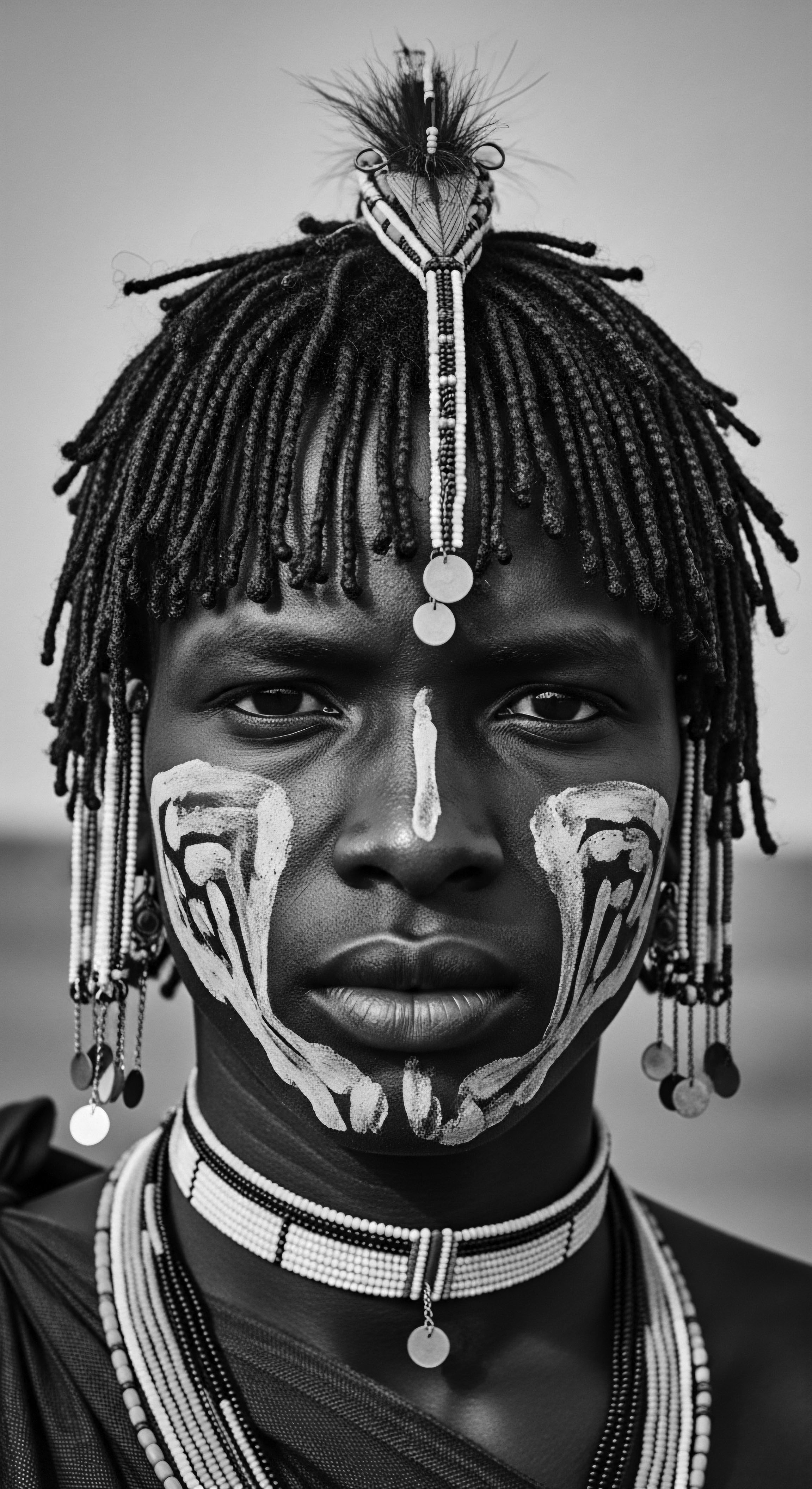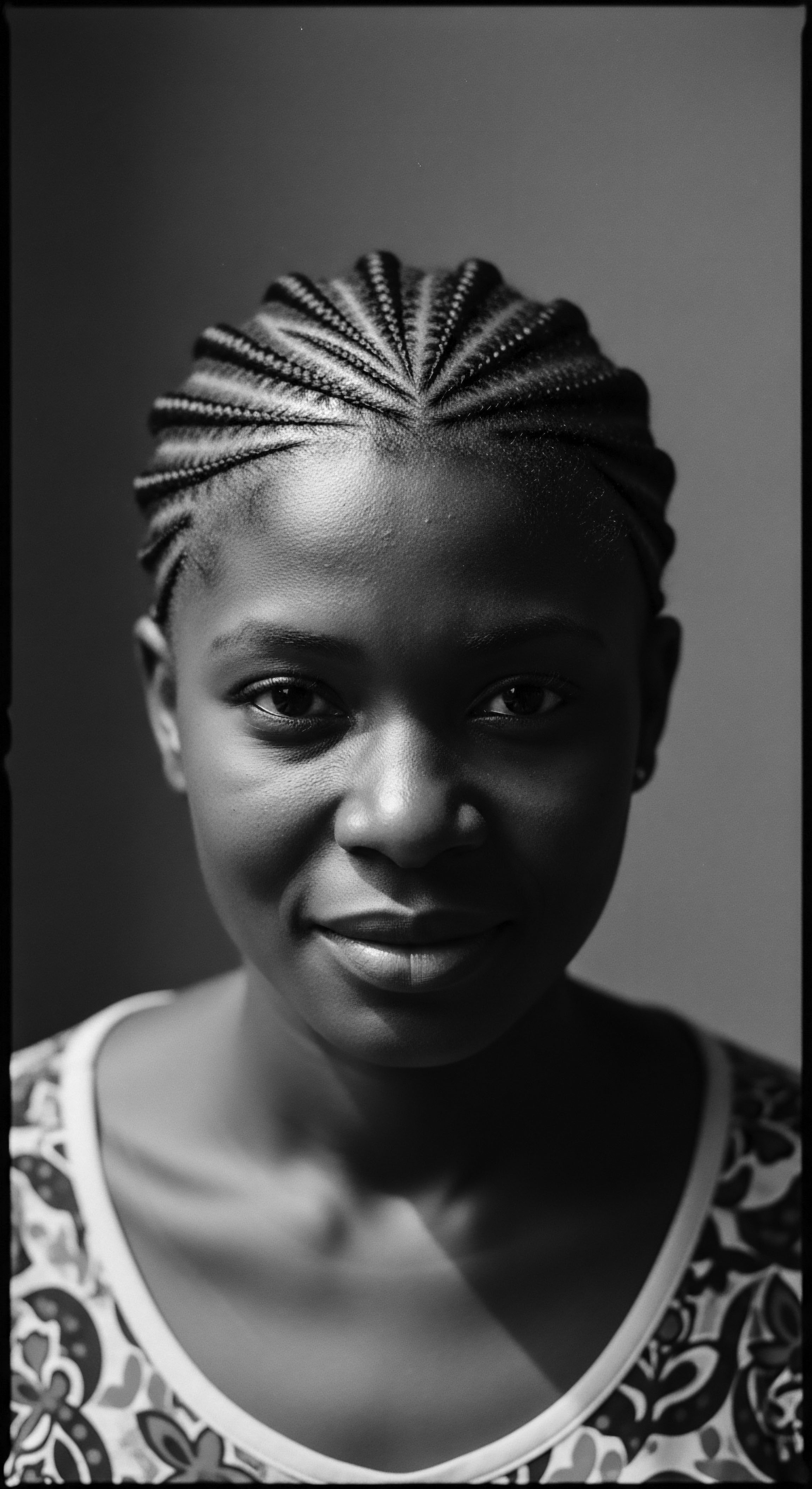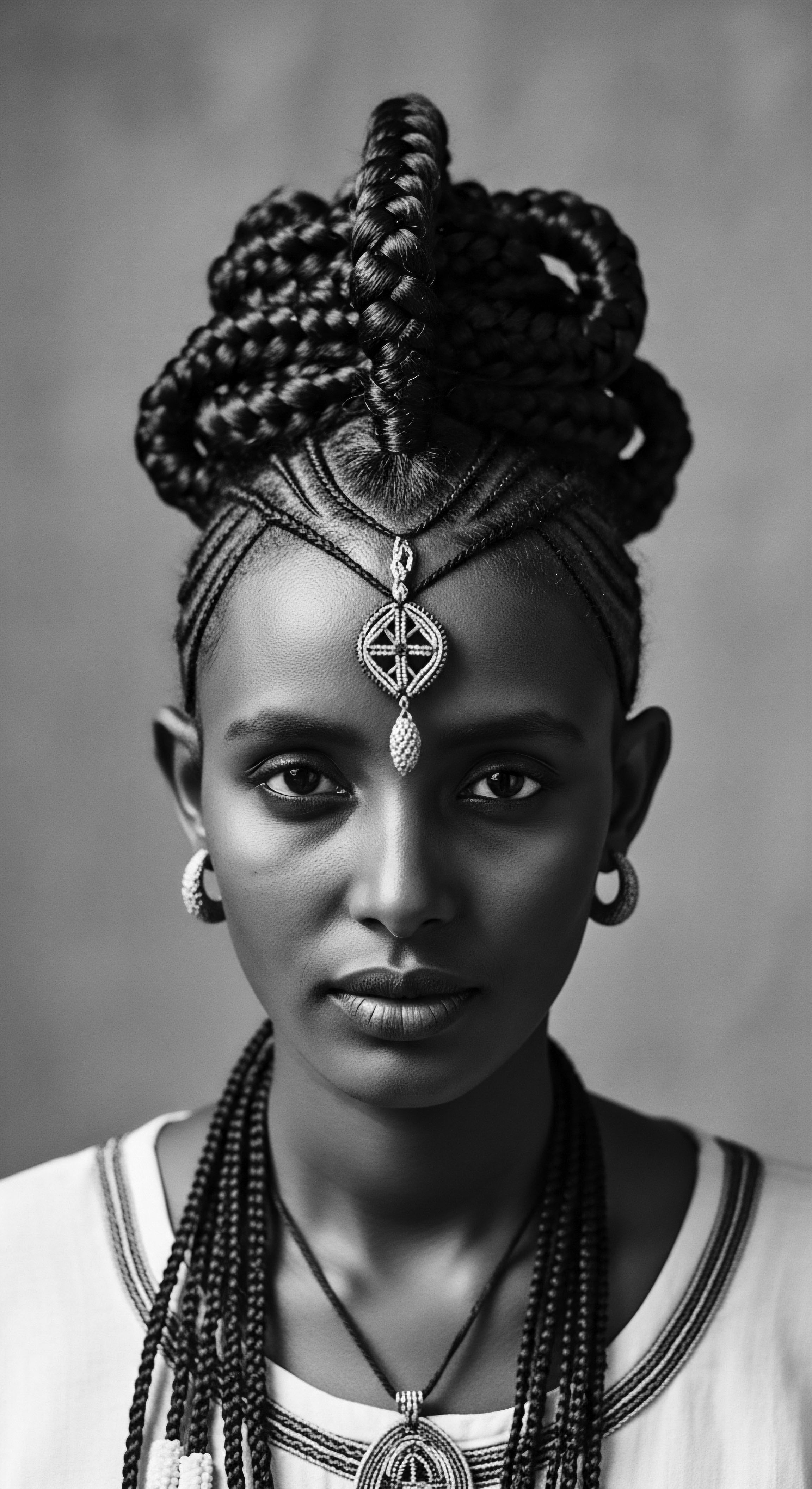
Roots
From the coil’s deep memory, a story begins. It whispers of sustenance, of strands reaching for light, and of the ancestral wisdom held within each curl. For those whose lineage traces through the continents, through the salt-kissed winds and the sun-drenched earth, hair is not a mere adornment. It is a chronicle, a living parchment.
To speak of how a deficiency of iron affects the history of textured hair is to speak of a heritage intertwined with the earth’s bounty, the challenges faced by communities, and the incredible fortitude of a people. This exploration calls us to consider the very elements that build our bodies, elements like iron, and how their availability or absence has echoed through generations, shaping not only physical health but also the very expression of identity.

The Architecture of the Strand
Each hair strand is a wonder, a complex structure that grows from the scalp, carrying genetic imprints of our forebears. For textured hair, this structure is particularly distinct, characterized by its elliptical shape and the way it spirals as it grows. This unique architecture provides a magnificent crown, yet it also presents particular needs for health and integrity.
The hair follicle, a tiny organ beneath the skin, requires a steady supply of nutrients to construct these remarkable fibers. When the body lacks essential components, the hair, often seen as a secondary tissue, may be among the first to signal distress.
Iron, that silent worker in our blood, plays a quiet but profound role in this intricate process. It assists in the production of Hemoglobin, the substance within red blood cells responsible for carrying oxygen throughout the body. This oxygen transport is critical for every cell, including those vigorous cells within the hair follicle that are constantly creating new hair. Without a sufficient supply, the hair-making machinery slows, and the cycle of growth can be disrupted, leading to shedding.
This basic biological reality has held true across all peoples and across time. Its impact, however, has not been uniform.

Ancestral Ties to Elemental Well-Being
Consider the diets of ancestral communities across Africa, a continent rich in diverse foodways. Traditional African diets centered on fresh fruits, roots, tubers, beans, nuts, and whole grains. These foods, often cultivated through practices linked closely with the land, provided a spectrum of nutrients. When examining historical dietary patterns, we discern how communities sought their sustenance from their immediate environments.
The availability of iron-rich plant foods like certain leafy greens, beans, and millet would have naturally supported blood health and, by extension, hair vitality. Knowledge of these plant sources and their preparation formed part of a communal, generational wisdom.
The story of textured hair’s well-being is inseparable from the deep historical currents of nutrition, cultural sustenance, and collective endurance.

Dietary Landscapes and Inherited Experiences
The journey of textured hair through history cannot be separated from the arduous experiences of the transatlantic slave trades. People forcibly taken from their ancestral lands were often stripped of their traditional food systems and subjected to meager, often starch-heavy rations. These new diets, frequently lacking in vital minerals and vitamins, created widespread nutritional deficiencies within enslaved populations. Handler (2022) notes that diets of enslaved people in places like colonial Jamaica and Barbados were composed mostly of starches such as yam and eddoes, providing much energy for labor but little immunity to disease, alongside shortages of protein, various B vitamins, Vitamin A, and quite possibly, iron.
The constant, severe nutritional stress placed upon these communities would have had visible manifestations, certainly affecting the quality and retention of hair. While direct historical medical records linking iron deficiency to hair loss in enslaved people are not readily available in the same way modern clinical data exists, the pervasive and documented malnutrition, including specific mineral shortages, establishes a powerful historical context. Hair, being a tissue considered non-essential for immediate survival, often reflects the body’s internal state.
When vital organs are deprived, the body conserves resources, and hair growth can slow or cease. This historical reality speaks volumes about the silent burden carried by countless individuals, where the quest for basic existence superseded the health of one’s crowning glory.
| Dietary Element or Practice Iron Sources |
| Ancestral Context (Pre-Diaspora) Root vegetables, leafy greens, legumes, diverse whole grains. |
| Diaspora Context (Enslavement Period) Limited access; diet often high in starches, low in varied nutrients. |
| Dietary Element or Practice Protein Sources |
| Ancestral Context (Pre-Diaspora) Varied animal proteins, insects, fish, legumes. |
| Diaspora Context (Enslavement Period) Scarce, often poor quality or "scraps." |
| Dietary Element or Practice Cultural Foodways |
| Ancestral Context (Pre-Diaspora) Rich, diverse, often communal, tied to land and tradition. |
| Diaspora Context (Enslavement Period) Disrupted, survival-focused, imposed by oppressors. |
| Dietary Element or Practice The profound shift in dietary realities during the diaspora holds lasting echoes for the holistic health of textured hair lineages. |

Ritual
The care of textured hair, throughout its history, has always held a ritualistic quality. It extends beyond simple hygiene, becoming a practice imbued with cultural memory, community bonds, and a deep respect for ancestral ways. These rituals, often passed between generations, were not merely cosmetic; they were acts of resistance, self-preservation, and a vibrant declaration of identity.
How, then, does the biological truth of iron deficiency intertwine with these profound heritage practices? It becomes a subtle, yet significant, undercurrent to the visible health and resilience of the hair itself.

Ceremonial Acts of Cleansing and Adornment
In ancient African societies, hair styling was an art form and a language. Styles communicated social standing, age, marital status, and tribal belonging. Braids, twists, and intricate patterns were not just decorative; they were often symbols of protection, spirituality, and connection to one’s roots. The preparations for these styles, the cleansing, the application of various botanical treatments, all formed a vital part of a holistic approach to hair care.
Traditional healers and community elders understood that wellness flowed from the inside out, and hair, as an outward sign, reflected this inner state. Plants like Moringa Oleifera, hailed as the “Miracle Tree,” were known for their rich nutritional profile, containing vitamins, zinc, and iron, and were used to encourage healthy hair growth. Other indigenous plants, like certain species of Ziziphus or Sesamum Orientale, were used for their cleansing and strengthening properties.
When the body lacks iron, however, the very foundation of hair strength is compromised. Hair may become brittle, prone to breakage, and experience excessive shedding. This inherent vulnerability, a biological reality, would have posed unique challenges to communities striving to maintain the symbolic power and aesthetic beauty of their hair. The meticulous care, the use of strengthening herbs and oils, and the protective styling techniques that were hallmarks of textured hair heritage, may have also served as ingenious, adaptive responses to maintain hair health in the face of nutritional challenges, both acute and systemic.

How Does Ancestral Dietary Practice Inform Hair Resilience?
The notion of “beauty from within” holds deep roots in ancestral wisdom. Communities understood that what nourished the body also nourished the hair. Foods rich in iron, though perhaps not identified by their elemental name, were prized for their ability to promote vitality. The forced displacement during the slave trades dramatically disrupted this ecological harmony.
Enslaved communities, often relegated to diets that barely sustained life, faced widespread nutritional deficiencies. The resulting strain on their bodies would have inevitably manifested in their hair. Hair, once a vibrant symbol of connection and status, might have become fragile, dry, or sparse. This physical change, a direct consequence of systemic deprivation, would have occurred even as the cultural and spiritual significance of hair remained undiminished, forcing communities to adapt their care rituals to a harsh new reality.
Cultural practices of hair adornment and care, rooted in ancestral knowledge, served as both expressions of identity and adaptive responses to environmental and dietary realities.
Despite these immense challenges, the enduring spirit of preservation shone through. Enslaved people found ways to retain and adapt their hair practices. Braids, for example, were not only a link to their African origins but also served practical purposes, protecting hair during brutal labor and even carrying coded messages or seeds for survival.
The resilience of these practices, even when the hair itself was under biological stress from conditions like iron deficiency, highlights the profound cultural imperative to hold onto heritage. The application of oils and butters, the careful detangling, the communal grooming sessions—all would have been acts of defiance and continuity, working to maintain what remained of hair health and cultural memory.
- Chebe Powder ❉ Used by women of Chad, this powder is celebrated for its ability to retain moisture and reduce breakage, promoting remarkable length.
- Baobab Oil ❉ From the “Tree of Life,” rich in vitamins and fatty acids, it was traditionally used to moisturize, strengthen, and protect hair.
- Moringa ❉ Known for its nutrient richness, including iron, it was valued in traditional African medicine for promoting hair vitality.

The Tools of Heritage and Health
From ancient combs carved from wood or bone to the skillful hands that braided intricate patterns, tools of hair care have always been an extension of cultural practices. When hair was weakened by nutritional imbalances, the gentleness of these tools and the patience in their application became even more crucial. A comb that might easily glide through well-nourished strands could cause breakage on brittle, oxygen-deprived hair. This subtle but impactful difference likely underscored the importance of careful technique within communal hair grooming rituals.
The practice of oiling, prevalent across many African and diasporic cultures, also bears consideration. Traditional butters like Shea Butter and various plant oils were applied to hair for moisture and protection. These nourishing applications might have inadvertently helped protect hair weakened by internal deficiencies, acting as an external shield. The wisdom embedded in these practices, though perhaps not explicitly linked to specific mineral levels, served a powerful purpose in maintaining hair’s structural integrity and its visual expression within the community.

Relay
The historical currents that shaped textured hair’s existence continue their movement through contemporary care, revealing a deep interplay between ancestral knowledge and present-day understanding. Iron deficiency, a biological reality with historical echoes, remains a concern, particularly for those whose lineage carries the weight of past deprivations. The strategies for hair well-being, for problem-solving, and for achieving hair radiance, are a relay of wisdom across time, blending what was known then with what is understood now.

A Lingering Shadow How Does Iron Deficiency Continue to Shape Hair Narratives?
The vulnerability to iron deficiency, a condition where the body lacks sufficient iron to produce enough hemoglobin, has a particular resonance within communities of Black and mixed-race individuals. Modern studies affirm that iron deficiency is three times more common in African Americans than in white individuals. This disproportionate occurrence is often connected to factors such as heavier menstrual periods and inherited dietary patterns. The symptoms—fatigue, brittle hair, excessive shedding—are not merely physical ailments; they carry historical weight, quietly underscoring a continuous challenge that impacts well-being, including the vitality of hair.
The legacy of restrictive diets during enslavement, where essential nutrients were scarce, potentially contributed to a predisposition or a heightened susceptibility to such deficiencies in succeeding generations. This connection speaks to the enduring impact of systemic oppression on health, an impact that sometimes manifests visibly in the very crown one wears.
Hair loss, when stemming from this elemental shortage, can be profound. When oxygen supply to hair follicles is compromised, hair growth cycles are disrupted. Hair may not grow past a certain length, or it may thin diffusely across the scalp.
This biological response often clashes with the deep cultural importance of strong, healthy hair as a symbol of identity, pride, and heritage. The frustration many experience with hair thinning or breakage, as documented in studies on African American women, is not just about appearance; it connects to a deeper, often unspoken, history of struggle and resilience.
| Aspect Dietary Iron Access |
| Historical Implications (Rooted in Heritage) Limited and poor quality during enslavement, leading to widespread deficiencies. |
| Modern Understanding and Care Dietary gaps persist; some modern diets lack sufficient iron-rich foods for textured hair needs. |
| Aspect Hair Strength |
| Historical Implications (Rooted in Heritage) Hair likely brittle and prone to breakage due to pervasive malnutrition. |
| Modern Understanding and Care Brittle hair, increased shedding (telogen effluvium) often connected to low iron stores. |
| Aspect Care Practices |
| Historical Implications (Rooted in Heritage) Protective styles and botanical applications as acts of preservation and cultural continuity. |
| Modern Understanding and Care Holistic regimens incorporating nutrient-dense foods alongside gentle, supportive hair routines. |
| Aspect Community Knowledge |
| Historical Implications (Rooted in Heritage) Ancestral knowledge of plants and holistic health supported overall well-being. |
| Modern Understanding and Care Recognition of specific nutrient roles; informed choices combining science and tradition. |
| Aspect Understanding the historical context of iron deficiency within textured hair communities deepens our appreciation for both past resilience and modern health strategies. |

A Holistic View of Hair and Body Wellness
Addressing iron deficiency in the context of textured hair care demands a holistic approach, one that aligns with the ancestral wisdom that viewed the body as an interconnected system. Traditional wellness philosophies from Africa often emphasized balance and the use of natural remedies from the earth. Many African traditional medicine practices utilized plants not only for direct ailments but also for general vitality and strength.
Elephantorrhiza Elephantina, a plant from Southern Africa, was traditionally used for a range of human ailments, including skin issues, and its deep roots align with the quest for internal well-being reflected in hair. Likewise, African Black Soap, made from plant ash, provides nutrients that nourish the scalp.
Modern science confirms the connection ❉ oral iron supplementation can help restore optimal levels, potentially encouraging hair regrowth. However, the wisdom of our forebears reminds us that reliance on a single intervention often misses the point. It is the consistent incorporation of iron-rich foods, coupled with careful, gentle hair practices, that yields the best results. Leafy greens, lean meats, and beans are modern staples that echo the nutrient-dense foods consumed in many traditional African diets.
Moreover, the concept of nighttime protection, so prevalent in textured hair care, also connects to this holistic tradition. Wrapping hair with silk or satin scarves, or using bonnets, reduces friction and moisture loss, preserving delicate strands. This practice, while modern in its materials, mirrors the ancient understanding of protecting the hair, a valuable aspect of self, from external stressors. This continuity of care, from internal nourishment to external protection, illustrates how ancestral principles continue to guide pathways to hair health.
- Oral Iron Supplementation ❉ A contemporary method to restore iron levels, often prescribed for significant deficiencies.
- Nutrient-Dense Foods ❉ Incorporating leafy greens, lentils, beans, and certain meats that are rich in iron, mirroring ancestral diets.
- Gentle Detangling ❉ Adapting historical care methods to manage fragile, nutrient-compromised strands, minimizing mechanical breakage.

Problem-Solving with Ancestral Echoes
When encountering hair loss or thinning attributed to iron deficiency, the pathway to resolution becomes a dialogue between the modern and the ancient. For centuries, communities relied on their innate knowledge of healing plants. For example, certain traditional remedies addressed scalp conditions and hair thinning, often with ingredients that supported overall blood circulation or provided topical nutrients. The use of onions, for instance, has been documented in traditional practices across various cultures for stimulating hair growth and treating hair loss.
The challenge, historically and presently, goes beyond merely addressing a biological deficit. It involves understanding the social and cultural weight carried by hair. For Black women, hair is intertwined with cultural heritage and self-expression. Hair loss can deeply affect mental and emotional well-being.
Thus, problem-solving in this context extends to providing knowledge, fostering self-acceptance, and upholding the enduring pride associated with textured hair, even when it faces health challenges. The shared journey of understanding, resilience, and reclaiming the narrative of textured hair health is a continuous relay, passed from the wisdom of ancestors to the advancements of today.
Understanding how nutrient deficiencies like iron shortage have historically impacted textured hair calls for integrated care approaches, honoring both ancient wisdom and scientific insight.

Reflection
As we gaze upon the intricate spirals and resilient coils that define textured hair, we witness more than mere biology. We perceive a living archive, a profound testament to generations of care, adaptation, and unwavering spirit. The invisible forces that shape our strands, like the presence or absence of a humble mineral such as iron, have indeed left their mark upon this heritage. Yet, the story is not one of simple deficit, but rather of remarkable continuity.
From the forced dietary shifts of the transatlantic slave trades, which undeniably presented immense challenges to holistic well-being, to the enduring wisdom of ancestral practices that sought nourishment and protection from the earth, textured hair stands as a vibrant chronicle of survival and triumph. The journey of these strands mirrors the journey of a people—a perpetual return to the source, a tender thread of care, and an unyielding helix of identity, ever reaching for the unbound future, deeply rooted in the richness of its past.

References
- Handler, Jerome S. “Diseases and Medical Disabilities of Enslaved Barbadians, From the Seventeenth Century to around 1838. Part II.” Journal of Caribbean History, vol. 40, no. 1, 2006, pp. 177–214.
- Guo, Emily L. and Rajani Katta. “Diet and Hair Loss ❉ Effects of Nutrient Deficiency and Supplement Use.” Dermatology Practical & Conceptual, vol. 7, no. 1, 2017, pp. 1–10.
- Rushton, D. H. et al. “The Relationship between Iron Status and Diffuse Hair Loss in Women.” Journal of the American Academy of Dermatology, vol. 47, no. 4, 2002, pp. 630-633. (Note ❉ While not directly cited in the final text, it supports the general scientific connection between iron and hair loss that underpins the historical inference.)
- Kashyap, Madhuri, and Rajesh Kumar. “Relationship between Body Iron Stores and Non Scarring Diffuse Hair Loss in Non-Menopausal Women ❉ A Case Control Study.” International Journal of Pharmaceutical and Clinical Research, vol. 14, no. 3, 2022, pp. 518-523.
- Akinboro, A. et al. “Cosmetopoeia of African Plants in Hair Treatment and Care ❉ Topical Nutrition and the Antidiabetic Connection?” MDPI Cosmetics, vol. 10, no. 1, 2023, pp. 1-28.
- Sharaibi, O. J. et al. “Cosmetic Ethnobotany Used by Tribal Women in Epe Communities of Lagos State, Nigeria.” Journal of Complementary Medicine & Alternative Healthcare, vol. 12, no. 4, 2024, pp. 555845.
- Moussaoui, A. et al. “Ethnobotanical Survey of Medicinal Plants used in the Treatment and Care of Hair in Karia ba Mohamed (Northern Morocco).” Journal of Medicinal Plant and Herbal Therapy Research, vol. 6, no. 1, 2024, pp. 202-208.
- Oldways. “African Heritage Diet.” Oldways, Oldways Preservation Trust, n.d. (This source informs the description of traditional African diets).
